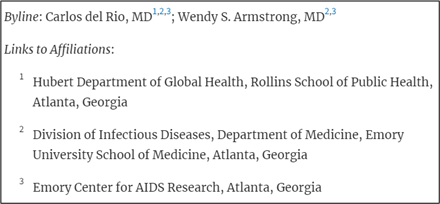
Author affiliation in research papers is an important element because it offers readers useful information about where the research was conducted. However, the time from research to manuscript creation and then publication is so long that by the time the research paper is published authors may have moved to a different institution or location.
In such cases, researchers may have questions about how these affiliation changes could be handled because it’s important for readers to know both old and new author affiliations in research papers. This article aims to answer a few common questions researchers may have regarding this process.
1. Do I need an affiliation for journal publication? Can I list multiple author affiliations in research papers?1
In academic publishing, an affiliation is the university or institution to which an author belongs or where authors have conducted a major part of the research that is discussed in their paper. Author affiliation in research papers is usually listed after the author names and provide credibility to the research and give readers confidence that the research is backed by an institution or university. The name of the institution clarifies who oversees the research integrity because these institutes usually have review boards that approve the research conducted at their institute. Because of the increase in the number of international collaborations among authors, an individual author may have multiple affiliations, all of which must be listed in the paper to ensure transparency. However, while some manuals or journal style guides may restrict the number of affiliations per author (e.g., APA manual, 7th ed, no more than 2 affiliations per author; AMA style manual, no more than 1 or 2 affiliations per author in some types of manuscripts like viewpoints or research letters), other journals may have no such restrictions.2

2. What should my author affiliation in research papers be if my workplace changes after manuscript submission? Can/should I mention both old and new author affiliations in research papers?3
Usually, it is acceptable to mention both current and previous author affiliations in research papers. In general, if your research was primarily conducted at your previous institution using its resources, then this institute should definitely be included in the author affiliations. This same institution should also be mentioned in the Materials and Methods section of your paper and as the sponsor of your work. However, the name of your current institute should also be mentioned so that readers could contact you if required. Different journals or publishers may have different rules for listing old and new author affiliations in research papers, so it is always advisable to consult the specific journal’s instructions for authors.
Here are a few examples of how different publishers or journals address pre- and post-submission changes in author affiliations in research papers:
- The American Medical Association’s style manual (11th edition): As per the American Medical Association’s style manual’s rules for author affiliation in research papers, if the author has moved after submitting a manuscript, the current affiliation should still be provided to the journal so that it could be added to the list of affiliations.
- Cambridge University Press: As per the Cambridge University Press’s rules for author affiliation in research papers, if an author has moved before manuscript submission, the current affiliation could be included under Acknowledgments.
- Sage journals: As per Sage journals’ rules for author affiliation in research papers, an author must include new affiliations after submission as a note at the end of the manuscript.
- American Chemical Society Publications, Wiley: As per American Chemical Society Publication’s rules for author affiliation in research papers, if the current address of the author is different from the one where the research was conducted, then this current address should be included in a footnote on the title page.
3. Is it possible to change author affiliation in research papers after the manuscript is accepted/has already been published?
Most journals accept requests for changes in author affiliation in research papers after acceptance, although there are a few exceptions. However, once an article has been published, changes may not necessarily be accepted or may require special permission and approval from the journal editor.
Listed below are a few examples of how different publishers address post-acceptance or post-publication requests for changes in author affiliation in research papers:
- Cambridge University Press:4 May accept an affiliation change request after submission in the event of a genuine reason. If the article has been published, a change in author affiliation in research papers would require the publishing of a linked correction notice.
- Taylor and Francis:5 If the authors have changed affiliations since completing their research, then the new affiliation can be acknowledged in a note; however, they don’t usually make changes to affiliations after accepting a manuscript for publication.
- Springer:6Do not update or change affiliations once an article has been published.
Author affiliations in research papers constitute an important part of the author information and should be mentioned accurately and clearly for all authors. Always refer to the journal or publisher’s instructions for authors for up-to-date information on the format for writing author affiliations in research papers. We hope this article has elaborated the importance of affiliations for journal publication and helped clarify any questions about handling changes in them.
Other Frequently Asked Questions (FAQ)
Q: What does author affiliation in research paper mean?
Author affiliation in research papers refers to the academic, research, or professional institutions to which the paper’s authors are affiliated. Usually mentioned below the author’s name, author affiliation in research papers are important as they provide important information about the author’s background and the context in which the research was conducted. Author affiliations help identify experts in specific fields or disciplines. They establish the credibility and trustworthiness of the research, and affiliations with top institutions add weight to the author’s work and indicate a higher level of expertise and academic rigor. This information also allows readers to identify potential conflicts of interest or connections, which fosters collaborations that further scientific progress.
Q: What is the first author’s affiliation?
The first author affiliation in a research paper refers to the institution or organization to which the lead author is primarily affiliated. The first author is the individual who makes the most substantial contribution to the research work, hence their affiliation is significant. This detail serves as an indicator of the research environment and resources available for the research project, which can bolster the credibility, reach, and impact of the research paper.
Q: Can an author have two affiliations?
Yes, it is possible for an author to have two or more affiliations. Authors may have joint appointments or collaborations between different institutions, allowing them to be affiliated with multiple organizations simultaneously. In such cases, authors often indicate their affiliations using superscript numbers or symbols to denote different institutions. This information helps readers understand the diverse institutional connections and collaborations of the authors.
References
- E. Bik. False affiliations and fake authors. Science Integrity Digest. Accessed December 15, 2022. https://scienceintegritydigest.com/2019/06/04/false-affiliations-and-fake-authors/
- American Medical Association style manual. 11TH edition, Section 2.3.3
- Q&A Forum. Editage Insights. Accessed December 16, 2022. https://www.editage.com/insights/what-should-my-affiliation-be-if-i-changed-my-workplace-during-a-manuscript-submission
- Author affiliations. Cambridge University Press. Accessed December 15, 2022. https://www.cambridge.org/core/services/authors/journals/author-affiliations#1a
- Defining authorship in your research paper. Author services: Taylor & Francis. https://authorservices.taylorandfrancis.com/editorial-policies/defining-authorship-research-paper/
- Authorship principles. Springer. Accessed December 15, 2022. https://www.springer.com/gp/editorial-policies/authorship-principles
Researcher.Life is a subscription-based platform that unifies the best AI tools and services designed to speed up, simplify, and streamline every step of a researcher’s journey. The Researcher.Life All Access Pack is a one-of-a-kind subscription that unlocks full access to an AI writing assistant, literature recommender, journal finder, scientific illustration tool, and exclusive discounts on professional publication services from Editage.
Based on 21+ years of experience in academia, Researcher.Life All Access empowers researchers to put their best research forward and move closer to success. Explore our top AI Tools pack, AI Tools + Publication Services pack, or Build Your Own Plan. Find everything a researcher needs to succeed, all in one place – Get All Access now starting at just $17 a month!


